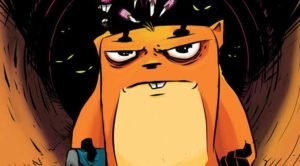Worse Things Happen At Sea v No Place Like Space
No-Brow Press, 2017 / Helio Press, 2017
Writer (and artist) of “Worse Things Happen At Sea: Kellie Strøm
Writer (and artist) of “No Place Like Space”: Ashley Ronning
When is a comic a comic?
Independent publisher No Brow Press has a series of illustrated books under what we suppose is a sub-brand (rather than an imprint) called Leporello, which are perhaps, elusively, termed “educational”. The first title in this comparative review, Worse Things Happen At Sea, is one of those works.
The comic is a gatefold, describing the beasts which confront and devour men at sea. There are no sequential panels which tell a story. Instead, we read a text-less series of drawings whereby seagoing vessels of various eras battle enormous, exotic kaiju monsters. These images are beautifully rendered:

The title of the comic comes from an English proverb, that “things could be worse.” No Brow’s promotional text delves into the meaning of the comic:
Worse Things Happen at Sea utilizes Nobrow’s popular Leporello series to allow Strøm to flex his drawing muscles and come up with a monster of a concertina book. Inspired by tales of mythical sea creatures and the tall stories of doomed voyages passed down from sailor to son, Strøm brings us a rich tapestry of wonderment. Historical ships are attacked, enveloped and engorged by monstrous creatures surfacing from the deepest depths of the darkest oceans. Covering 20 panels each measuring 13.8cm x 23.5cm the image unfolds in front of you like a foreboding fable from the cracked lips of an old sea captain.
Taking over two years to create, the faux engraved colour separation style used for this project has been a departure from his two previous picture books, both illustrated with full colour acrylic paintings. In both techniques Strøm wrestled with creating detailed immersive worlds while also trying to preserve some of the immediacy of the original physical art.
Each image conveys a silent story of disaster, and spawns questions: why did these giant creatures appear from the depths across the ages to wreak havoc? Are they the monsters that spawn the myths? What will happen to their victims – are they consumed by monster or by sea? The reader cannot look at the images without conjuring their own narrative.
But is this a comic? We purchased it at Topping and Company Booksellers of Bath, in the United Kingdom, where it comfortably nestled amidst Neil Gaiman’s The Sandman and similar titles.
Worse Things Happen At Sea is set at various time periods in the ocean. Our second title, called No Place Like Space (by Australian creator Ashley Ronning) in this review is set on the moon in a future as envisaged in the 1970s.

Again, there is no text to accompany the graphics. There is only one panel on every page. Each of those panels is a shot of a mundane aspect of life on a lunar colony, seen through the perspective of 1970s futurism. There has been a non-fiction, or rather, historical revisitation over the past few years of 1950s-1980s visions of the future. This publication is one of those. It is funny, quirky, and nostalgic. A lunar colony envisaged in the 1970s could have been entirely nonchalant, boring to distraction.
This comic is so short that we could (but do not) have happily included the entire issue within this review:

It actually looks more like the sort of catalogue which you obtain at art gallery exhibition openings. Is this title actually a comic? It was displayed amongst some other independently published comics (including , which we have previously reviewed) at Many, an arts collective occupying a vacant store in the port town of Fremantle in Western Australia.

The question of whether both of these comics is actually a comic or not is akin to the enquiry of time immemorial: “But is it art?” We have no answer for you, other than to note that if someone thinks that each of these respective publications is a comic, then it must be a comic.

